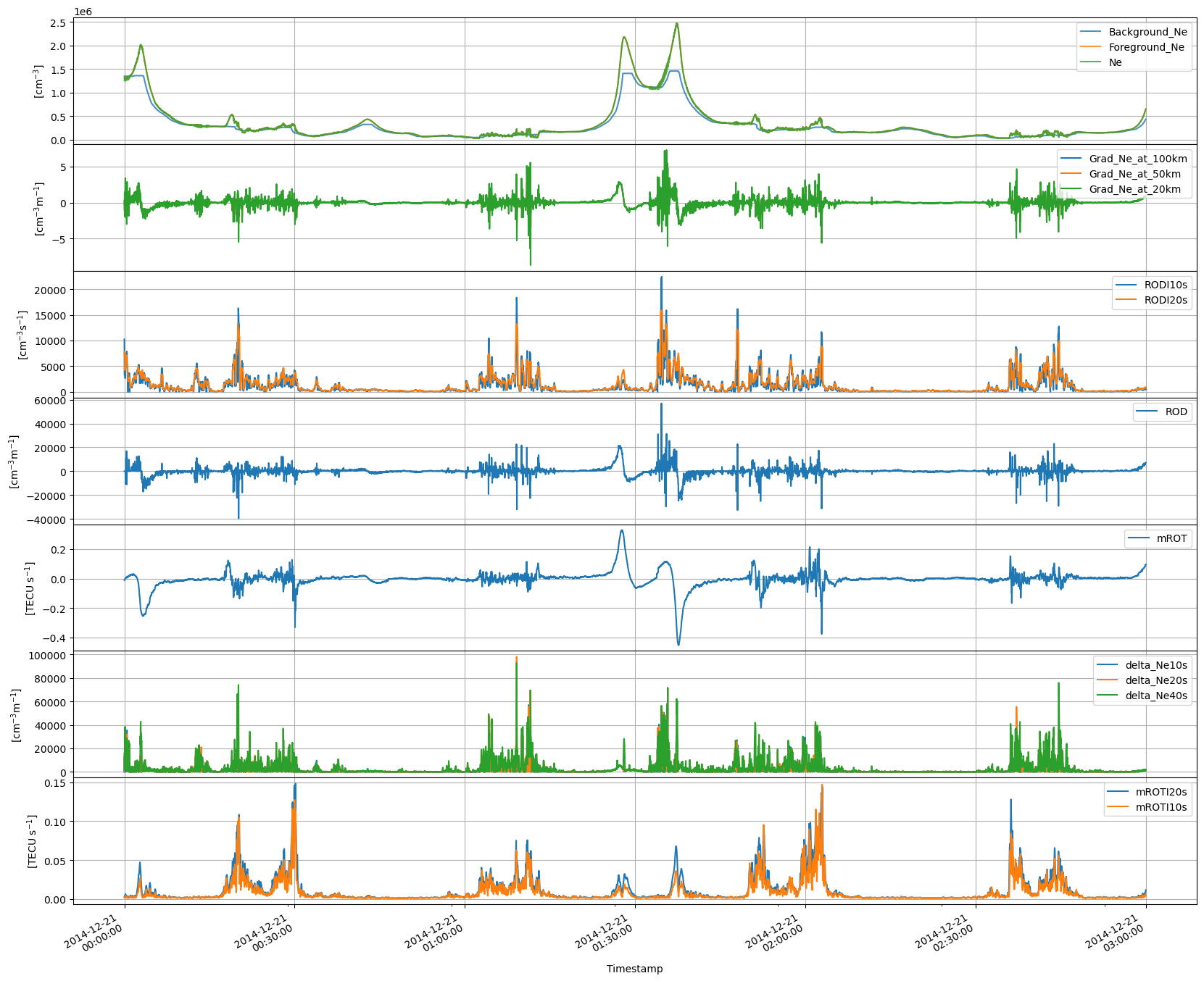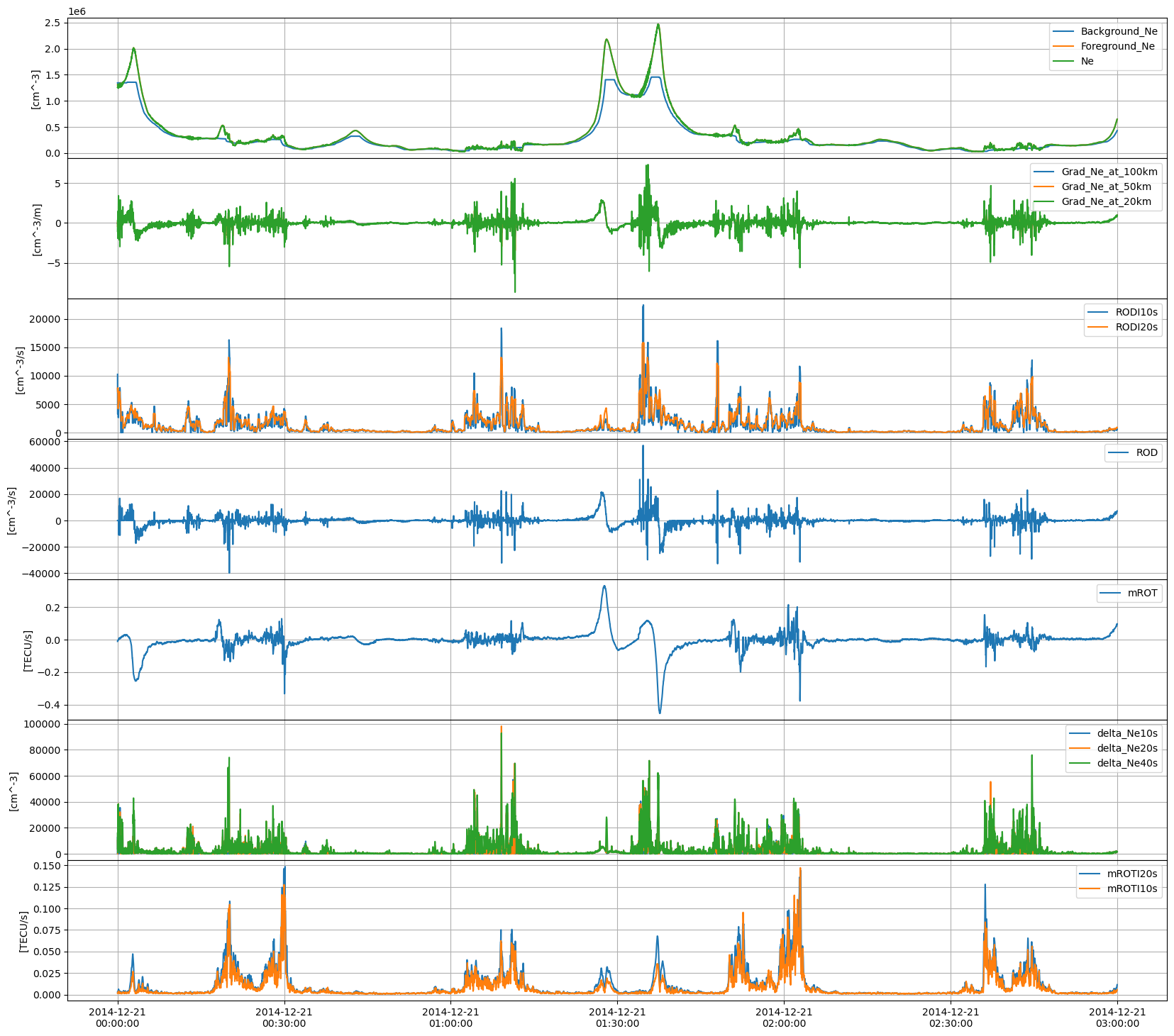IPDxIRR_2F (Ionospheric plasma densities)#
Abstract: Access to the derived plasma characteristics at 1Hz (level 2 product).
%load_ext watermark
%watermark -i -v -p viresclient,pandas,xarray,matplotlib
Python implementation: CPython
Python version : 3.11.6
IPython version : 8.18.0
viresclient: 0.12.3
pandas : 2.1.3
xarray : 2023.12.0
matplotlib : 3.8.2
from viresclient import SwarmRequest
import datetime as dt
import matplotlib.pyplot as plt
from matplotlib.dates import DateFormatter
request = SwarmRequest()
IPDxIRR_2F product information#
Derived plasma characteristics at 1Hz, for each Swarm spacecraft.
Documentation:
Check what “IPD” data variables are available#
request.available_collections("IPD", details=False)
{'IPD': ['SW_OPER_IPDAIRR_2F', 'SW_OPER_IPDBIRR_2F', 'SW_OPER_IPDCIRR_2F']}
request.available_measurements("IPD")
['Ne',
'Te',
'Background_Ne',
'Foreground_Ne',
'PCP_flag',
'Grad_Ne_at_100km',
'Grad_Ne_at_50km',
'Grad_Ne_at_20km',
'Grad_Ne_at_PCP_edge',
'ROD',
'RODI10s',
'RODI20s',
'delta_Ne10s',
'delta_Ne20s',
'delta_Ne40s',
'Num_GPS_satellites',
'mVTEC',
'mROT',
'mROTI10s',
'mROTI20s',
'IBI_flag',
'Ionosphere_region_flag',
'IPIR_index',
'Ne_quality_flag',
'TEC_STD']
Fetch three hours of IPD data#
request.set_collection("SW_OPER_IPDAIRR_2F")
request.set_products(measurements=request.available_measurements("IPD"))
data = request.get_between(
dt.datetime(2014,12,21, 0),
dt.datetime(2014,12,21, 3)
)
Load and plot using pandas/matplotlib#
df = data.as_dataframe()
df.head()
| mVTEC | mROTI10s | ROD | delta_Ne20s | Te | RODI10s | Longitude | IBI_flag | TEC_STD | mROT | ... | mROTI20s | Latitude | Spacecraft | Background_Ne | Grad_Ne_at_100km | Radius | delta_Ne40s | RODI20s | Grad_Ne_at_50km | Grad_Ne_at_20km | |
|---|---|---|---|---|---|---|---|---|---|---|---|---|---|---|---|---|---|---|---|---|---|
| Timestamp | |||||||||||||||||||||
| 2014-12-21 00:00:00.196999936 | 51.786934 | 0.001472 | 0.0 | 10266.500 | 2212.278353 | 10238.517220 | -128.771412 | -1 | 3.131451 | -0.011013 | ... | 0.002676 | -4.693533 | A | 1343599.375 | -0.084919 | 6.840395e+06 | 3811.1 | 7764.002532 | -0.403940 | -1.047788 |
| 2014-12-21 00:00:01.196999936 | 51.768982 | 0.001386 | 0.0 | 2830.850 | 2165.194729 | 3263.138721 | -128.772618 | -1 | 3.122494 | -0.011013 | ... | 0.002732 | -4.757416 | A | 1343599.375 | -0.144009 | 6.840404e+06 | 16343.3 | 7181.496228 | 0.144877 | 0.338403 |
| 2014-12-21 00:00:02.196999936 | 51.746898 | 0.001310 | 0.0 | 0.000 | 1544.874194 | 3263.138721 | -128.773822 | -1 | 3.113830 | -0.008833 | ... | 0.002750 | -4.821298 | A | 1343599.375 | -0.058276 | 6.840413e+06 | 3246.4 | 7181.496228 | -0.123734 | 0.133643 |
| 2014-12-21 00:00:03.196999936 | 51.728759 | 0.001930 | 0.0 | 2194.925 | 1228.501871 | 3263.138721 | -128.775026 | -1 | 3.104259 | -0.008151 | ... | 0.003277 | -4.885179 | A | 1343599.375 | -0.144613 | 6.840422e+06 | 848.3 | 7390.308480 | -0.131441 | 1.443077 |
| 2014-12-21 00:00:04.196999936 | 51.711313 | 0.002434 | 0.0 | 9491.525 | 2681.512355 | 3263.138721 | -128.776229 | -1 | 3.097484 | -0.007051 | ... | 0.003744 | -4.949060 | A | 1343599.375 | -0.039358 | 6.840430e+06 | 6448.3 | 7554.331699 | -0.403369 | -1.948789 |
5 rows × 29 columns
df.columns
Index(['mVTEC', 'mROTI10s', 'ROD', 'delta_Ne20s', 'Te', 'RODI10s', 'Longitude',
'IBI_flag', 'TEC_STD', 'mROT', 'Ne_quality_flag', 'IPIR_index',
'Foreground_Ne', 'Ionosphere_region_flag', 'PCP_flag', 'delta_Ne10s',
'Num_GPS_satellites', 'Ne', 'Grad_Ne_at_PCP_edge', 'mROTI20s',
'Latitude', 'Spacecraft', 'Background_Ne', 'Grad_Ne_at_100km', 'Radius',
'delta_Ne40s', 'RODI20s', 'Grad_Ne_at_50km', 'Grad_Ne_at_20km'],
dtype='object')
fig, axes = plt.subplots(nrows=7, ncols=1, figsize=(20,18), sharex=True)
df.plot(ax=axes[0], y=['Background_Ne', 'Foreground_Ne', 'Ne'], alpha=0.8)
df.plot(ax=axes[1], y=['Grad_Ne_at_100km', 'Grad_Ne_at_50km', 'Grad_Ne_at_20km'])
df.plot(ax=axes[2], y=['RODI10s', 'RODI20s'])
df.plot(ax=axes[3], y=['ROD'])
df.plot(ax=axes[4], y=['mROT'])
df.plot(ax=axes[5], y=['delta_Ne10s', 'delta_Ne20s', 'delta_Ne40s'])
df.plot(ax=axes[6], y=['mROTI20s', 'mROTI10s'])
axes[0].set_ylabel("[cm$^{-3}$]")
axes[1].set_ylabel("[cm$^{-3}$m$^{-1}$]")
axes[2].set_ylabel("[cm$^{-3}$s$^{-1}$]")
axes[3].set_ylabel("[cm$^{-3}$m$^{-1}$]")
axes[4].set_ylabel("[TECU s$^{-1}$]")
axes[5].set_ylabel("[cm$^{-3}$m$^{-1}$]")
axes[6].set_ylabel("[TECU s$^{-1}$]")
axes[6].set_xlabel("Timestamp")
for ax in axes:
# Reformat time axis
# https://www.earthdatascience.org/courses/earth-analytics-python/use-time-series-data-in-python/customize-dates--matplotlib-plots-python/
ax.xaxis.set_major_formatter(DateFormatter("%Y-%m-%d\n%H:%M:%S"))
ax.legend(loc="upper right")
ax.grid()
fig.subplots_adjust(hspace=0)

Load as xarray#
ds = data.as_xarray()
ds
<xarray.Dataset>
Dimensions: (Timestamp: 10800)
Coordinates:
* Timestamp (Timestamp) datetime64[ns] 2014-12-21T00:00:00.19...
Data variables: (12/29)
Spacecraft (Timestamp) object 'A' 'A' 'A' 'A' ... 'A' 'A' 'A'
mVTEC (Timestamp) float64 51.79 51.77 ... 20.84 20.94
mROTI10s (Timestamp) float64 0.001472 0.001386 ... 0.005609
ROD (Timestamp) float64 0.0 0.0 ... 7.28e+03 7.28e+03
delta_Ne20s (Timestamp) float64 1.027e+04 ... 1.702e+03
Te (Timestamp) float64 2.212e+03 ... 1.723e+03
... ...
Grad_Ne_at_100km (Timestamp) float64 -0.08492 -0.144 ... 0.9621
Radius (Timestamp) float64 6.84e+06 6.84e+06 ... 6.835e+06
delta_Ne40s (Timestamp) float64 3.811e+03 ... 1.702e+03
RODI20s (Timestamp) float64 7.764e+03 7.181e+03 ... 907.9
Grad_Ne_at_50km (Timestamp) float64 -0.4039 0.1449 ... 0.9347 0.9775
Grad_Ne_at_20km (Timestamp) float64 -1.048 0.3384 ... 1.002 0.9148
Attributes:
Sources: ['SW_OPER_IPDAIRR_2F_20141221T000000_20141221T235959_0302']
MagneticModels: []
AppliedFilters: []Alternative plot setup#
To plot the data from xarray, we need a different plotting setup. This does however give us more control over the plot. The units are extracted directly from the xarray object.
fig, axes = plt.subplots(nrows=7, ncols=1, figsize=(20,18), sharex=True)
def subplot(ax=None, y=None, **kwargs):
"""Plot combination of variables onto a given axis"""
units = ds[y[0]].units
for var in y:
ax.plot(ds["Timestamp"], ds[var], label=var, **kwargs)
if units != ds[var].units:
raise ValueError(f"Units mismatch for {var}")
ax.set_ylabel(f"[{units}]")
# Reformat time axis
# https://www.earthdatascience.org/courses/earth-analytics-python/use-time-series-data-in-python/customize-dates--matplotlib-plots-python/
ax.xaxis.set_major_formatter(DateFormatter("%Y-%m-%d\n%H:%M:%S"))
ax.legend(loc="upper right")
ax.grid()
subplot(ax=axes[0], y=['Background_Ne', 'Foreground_Ne', 'Ne'])
subplot(ax=axes[1], y=['Grad_Ne_at_100km', 'Grad_Ne_at_50km', 'Grad_Ne_at_20km'])
subplot(ax=axes[2], y=['RODI10s', 'RODI20s'])
subplot(ax=axes[3], y=['ROD'])
subplot(ax=axes[4], y=['mROT'])
subplot(ax=axes[5], y=['delta_Ne10s', 'delta_Ne20s', 'delta_Ne40s'])
subplot(ax=axes[6], y=['mROTI20s', 'mROTI10s'])
fig.subplots_adjust(hspace=0)

